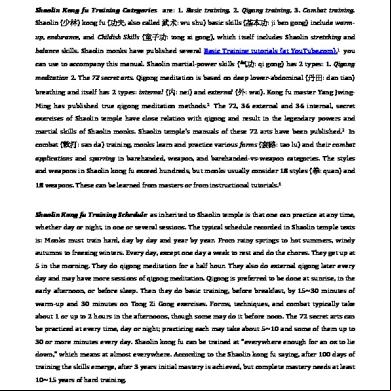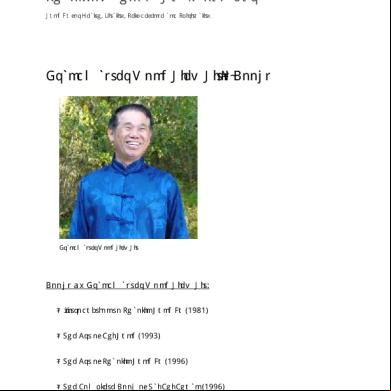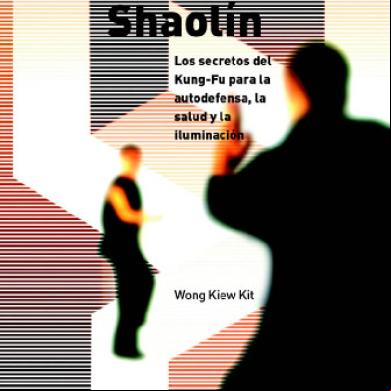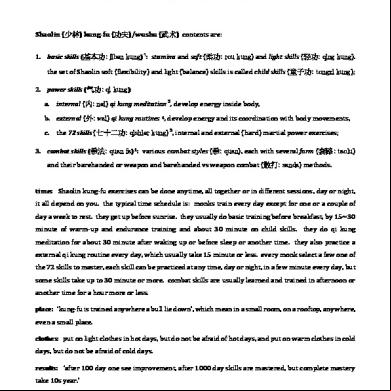Shaolin Kong Fu Training 8694e
This document was ed by and they confirmed that they have the permission to share it. If you are author or own the copyright of this book, please report to us by using this report form. Report 3b7i
Overview 3e4r5l
& View Shaolin Kong Fu Training as PDF for free.
More details w3441
- Words: 2,001
- Pages: 7
SHAOLIN Kong fu Training from the very beginning to the highest level achieved by the high monks of Shaolin temple
Shaolin Kong fu Training Categories are: 1. Basic training, 2. Qigong training, 3. Combat training. Shaolin (少林) kong fu (功夫, also called 武术: wu shu) basic skills (基本功: ji ben gong) include warmup, endurance, and Childish Skills (童子功: tong zi gong), which itself includes Shaolin stretching and balance skills. Shaolin monks have published several Basic Training tutorials (at YouTube.com),1 you can use to accompany this manual. Shaolin martial-power skills (气功: qi gong) has 2 types: 1. Qigong meditation 2. The 72 secret arts. Qigong meditation is based on deep lower-abdominal (丹田: dan tian) breathing and itself has 2 types: internal (内: nei) and external (外: wai). Kong fu master Yang JwingMing has published true qigong meditation methods.2 The 72, 36 external and 36 internal, secret exercises of Shaolin temple have close relation with qigong and result in the legendary powers and martial skills of Shaolin monks. Shaolin temple’s manuals of these 72 arts have been published.3 In combat (散打: san da) training, monks learn and practice various forms (套路: tao lu) and their combat applications and sparring in barehanded, weapon, and barehanded-vs-weapon categories. The styles and weapons in Shaolin kong fu exceed hundreds, but monks usually consider 18 styles (拳: quan) and 18 weapons. These can be learned from masters or from instructional tutorials.1
Shaolin Kong fu Training Schedule as inherited to Shaolin temple is that one can practice at any time, whether day or night, in one or several sessions. The typical schedule recorded in Shaolin temple texts is: Monks must train hard, day by day and year by year. From rainy springs to hot summers, windy autumns to freezing winters. Every day, except one day a week to rest and do the chores. They get up at 5 in the morning. They do qigong meditation for a half hour. They also do external qigong later every day and may have more sessions of qigong meditation. Qigong is preferred to be done at sunrise, in the early afternoon, or before sleep. Then they do basic training, before breakfast, by 15~30 minutes of warm-up and 30 minutes on Tong Zi Gong exercises. Forms, techniques, and combat typically take about 1 or up to 2 hours in the afternoons, though some may do it before noon. The 72 secret arts can be practiced at every time, day or night; practicing each may take about 5~10 and some of them up to 30 or more minutes every day. Shaolin kong fu can be trained at “everywhere enough for an ox to lie down,” which means at almost everywhere. According to the Shaolin kong fu saying, after 100 days of training the skills emerge, after 3 years initial mastery is achieved, but complete mastery needs at least 10~15 years of hard training. 1
More than 200 video tutorials by Shaolin Temple inheritors: SHAOLIN Kong fu instructional (at YouTube.com).
2
Books: “Qigong for Health and Martial Arts,” “Qigong Meditation: Embryonic Breathing,” “Qigong Meditation: Small Circulation,” and his other qigong books.
3
Books: “Training Methods of 72 Arts of Shaolin” and “72 Consummate Arts Secrets of the Shaolin Temple.” 1
SHAOLIN Kong fu Basic Training Warm-up: Warming up makes stretching easy and prevents injuries to muscles, tendons, and ligaments. Warm-up has 2 parts, Loosen-up and Endurance exercises: Loosen-up all ts from toe to head; it is necessary before stretching activities, and is recommended to be done in beginning of every training session. The following is the typical loosen-up routine of Shaolin monks; repeat each one several times, for example, 9 times to each side:
Rotate hands around the wrists, to both sides
Rotate forearms around the elbows, to both sides
Rotate arms around the shoulders, forward and backward
Toes down to floor, rotate ankles around, to both sides
Feet apart or together, rotate knees around, to both sides
Feet apart, rotate hips around, to both sides
Feet apart, rotate upper body around the waist, to both sides, arms swing with upper body
Feet apart, twist the back from side to side, arms swing with upper body
Rotate head around the neck, to both sides At last, loosen up whole body and shake all extremities.
Endurance Exercises are a basic requirement in Shaolin kong fu. Dynamic Endurance Exercises are categorized as part of warm-up and are done before stretching exercises. Begin endurance training lightly, but after a few minutes, do not be afraid if the exercises go beyond your endurable level; endurance increases gradually over time. There are various endurance exercises and the practitioner can do different ones each day:
Run
Run sideways, front leg bends in knee; switch direction
Run sideways, front leg bends in knee, alternate front and rear feet; switch direction
Run, twist upper body from side to side
Run, raise feet in behind, slap them
Run, raise feet in front, slap them
Run, raise knees high
Run, raise one knee and punch with opposite fist
Run, raise both knees up as you jump high
Run, do flying kicks with both legs
In squat position walk forward
In squat position leap forward
In squat position leap to sides
Roll forward and backward
Sprint forward and backward …and many other exercises! 2
Stretching Exercises: Begin each stretching exercise with holding the position, then a few, like 3~5, light stretching pulses to wake up the muscles, then stretch continuously in the position for 9 deep lower-abdominal breaths or so; then relax for some seconds to begin the next exercise. This way, each exercise takes 1 minute or so. Do all the exercises every training day until achieving the mastering level, at which you can assume the stretching Tong Zi Gong postures with ease. This may take 3 years of training. In that level of skill, you can abandon ordinary stretching training and, instead, do the Tong Zi Gong postures one after the other in a meditative (video at YouTube.com) or combative (video at YouTube.com) form. These are a complete set of typical exercises:
for posture 1: Both hands fixed on wall behind, squat down to stretch.
for posture 2: Feet apart, arc backward, try to land both palms on the floor at behind.
for posture 3: Stand, turn both toes inward as far as possible, bend down.
for posture 4: Stand, turn both toes outward as far as possible, sit down.
for posture 5: Feet apart, lean forward, try to your head and shoulders through your legs.
for posture 6: Sit down or stand up, try to hook your feet behind your neck, do with both legs.
for posture 7: One leg squats, other leg straight in front on heel with toes upward, hands clasp and drag the toes backward, bend forward and press your head to the leg; switch legs. At advanced level, you can assume front ‘clasping Buddha’s foot’ as a prerequisite for ‘posture 7.’ Try ‘front split,’ legs straight; switch legs. At advanced level, you can assume ‘posture 7’ itself.
for posture 8: * It is an advanced variant of ‘front split,’ try it after mastering front split.
for posture 9: One leg squats, other leg straight to the side on heel with toes upward, hands clasp and drag the toes backward, bend sideward and press your ear to the leg; switch legs. At advanced level, you can assume side ‘clasping Buddha’s foot’ as a prerequisite for ‘posture 9.’ Try ‘side split,’ legs straight. At advanced level, you can assume ‘posture 9’ itself. basic stretching kicks: ‘forward kick,’ ‘sideward kick,’ ‘inward crescent kick,’ ‘outward crescent kick.’
Begin all with feet near together, palms to sides, both legs straight while kicking, kick at the head level, take a half step with each kick, then kick with the other leg, repeat each kick 9 times or so with each leg.
forward
sideward
inward 3
outward
Shaolin Tong Zi Gong (Shaolin kong fu stretching and balance postures): Tong Zi Gong literally means ‘virgin child skills,’ and is recommended to be trained since childhood. However, it can be mastered at any age; many masters have begun practicing it when they have been more than 50 years old. The reason for this naming is said to be that if one masters Tong Zi Gong, being as soft as cotton and as light as a swallow, he will feel like being given a second childhood. As the sayings go, “Tong Zi Gong has 18 postures.” However, various variants of posture have emerged in the course of the centuries. These are 18 main postures (9 stretching and 9 balance) together with the most known variants:
Starting posture: 起势: qi shi, Salute!
Stretching Postures: (to be as soft as cotton)
1 1, advanced single-arm variant lazy monk praises Buddha Buddhist child shows the way 懒僧拜佛: lan seng bai fo 佛童指路: fo tong zhi lu
2, advanced variant 2 arc backward and conceal the flower under the leaf 叶底藏花: ye di cang hua clasp Buddha’s feet 下腰抱佛腳: xia yao bao fo jiao
3 sun and moon 日月: ri yue 4 golden tortoise 金龟: jin gui 4
4, equal single-leg variant crossing the river on a reed stem 一苇渡江: yi wei du jiang
5 head through the legs 6, double-leg variant green dragon coils in the nest 青龙盘窝: qing long pan wo
6, single-leg variant golden rooster stands on one leg 金鸡独立: jin ji du li
7, prerequisite variant front clasping Buddha’s foot 抱佛腳: bao fo jiao single/double leg aka 7 single/double stretching 7, equal lying variant front skyward step ligaments 7, prerequisite variant front split and 朝天蹬: chao tian deng 单/双拔筋: dan/shuang front split* clasping Buddha’s foot 竖叉: shu cha ba jin 跌叉抱佛脚: die cha bao fo jiao
*8, an advanced front split green dragon clasps its tail 青龙抱尾: qing long bao wei
9, prerequisite variant side clasping Buddha’s foot 抱佛腳: bao fo jiao 9 9, equal lying variant side skyward step side split and 朝天蹬: chao tian deng clasping Buddha’s foot 跌叉抱佛脚: die cha bao fo jiao
9, prerequisite variant side split 橫叉: heng cha 5
Balance Postures: (to be as light as a swallow) To learn some of these postures, you must first use the help of your hands, lean to a wall, or use another at the beginning levels. Assume some of these postures for 36, 72, 108, or even more breaths every day. Some people make them harder by, for example, doing push-ups or loading some weight to their body in some of them. There are numerous variants. These are the variants that are practiced by Shaolin monks, presented from the easiests to the hardest ones:
10 single-arm 单臂扶撑: dan bi fu cheng
11 child praises guan yin 童子拜观音: tong zi bai guan yin
13 arhat praises Buddha 罗汉拜佛: luo han bai fo aka child praises Buddha 童子拜佛: tong zi bai fo
12 swallow-like balance 燕式平衡: yan shi ping heng aka dragon explores out of the sea 蛟龙探海: jiao long tan hai
13, simpler variant single push palm 单推掌: dan tui zhang
14, lying variant sleeping arhat 罗汉睡觉: luo han shui jiao
14, sitting variant sleeping fish carries Buddha 卧鱼载佛: wo yu zai fo aka stubborn child praises Buddha 顽童拜佛: wan tong bai fo 6
15 meeting a Buddhist flying toward heaven 迎佛升天: ying fo sheng tian
16 double-arm 双臂扶撑: shuang bi fu cheng aka body hung on kneeling elbows 跪肘悬身: gui zhu xuan shen a combination of 15 and 16
17, prerequisite variant upside down loaded monument 倒载碑: dao zai bei
18 upside down balance on hands
17 upside down loaded monument 倒载碑: dao zai bei
18, advanced variants* upside down two-fingers meditation 倒立二指禅: dao li er zhi chan
Ending posture: 收势: shou shi Amituofo! _/\_ 7
*18, prerequisite variant arhat looks at troops formation 罗汉观阵: luo han guan zhen
Shaolin Kong fu Training Categories are: 1. Basic training, 2. Qigong training, 3. Combat training. Shaolin (少林) kong fu (功夫, also called 武术: wu shu) basic skills (基本功: ji ben gong) include warmup, endurance, and Childish Skills (童子功: tong zi gong), which itself includes Shaolin stretching and balance skills. Shaolin monks have published several Basic Training tutorials (at YouTube.com),1 you can use to accompany this manual. Shaolin martial-power skills (气功: qi gong) has 2 types: 1. Qigong meditation 2. The 72 secret arts. Qigong meditation is based on deep lower-abdominal (丹田: dan tian) breathing and itself has 2 types: internal (内: nei) and external (外: wai). Kong fu master Yang JwingMing has published true qigong meditation methods.2 The 72, 36 external and 36 internal, secret exercises of Shaolin temple have close relation with qigong and result in the legendary powers and martial skills of Shaolin monks. Shaolin temple’s manuals of these 72 arts have been published.3 In combat (散打: san da) training, monks learn and practice various forms (套路: tao lu) and their combat applications and sparring in barehanded, weapon, and barehanded-vs-weapon categories. The styles and weapons in Shaolin kong fu exceed hundreds, but monks usually consider 18 styles (拳: quan) and 18 weapons. These can be learned from masters or from instructional tutorials.1
Shaolin Kong fu Training Schedule as inherited to Shaolin temple is that one can practice at any time, whether day or night, in one or several sessions. The typical schedule recorded in Shaolin temple texts is: Monks must train hard, day by day and year by year. From rainy springs to hot summers, windy autumns to freezing winters. Every day, except one day a week to rest and do the chores. They get up at 5 in the morning. They do qigong meditation for a half hour. They also do external qigong later every day and may have more sessions of qigong meditation. Qigong is preferred to be done at sunrise, in the early afternoon, or before sleep. Then they do basic training, before breakfast, by 15~30 minutes of warm-up and 30 minutes on Tong Zi Gong exercises. Forms, techniques, and combat typically take about 1 or up to 2 hours in the afternoons, though some may do it before noon. The 72 secret arts can be practiced at every time, day or night; practicing each may take about 5~10 and some of them up to 30 or more minutes every day. Shaolin kong fu can be trained at “everywhere enough for an ox to lie down,” which means at almost everywhere. According to the Shaolin kong fu saying, after 100 days of training the skills emerge, after 3 years initial mastery is achieved, but complete mastery needs at least 10~15 years of hard training. 1
More than 200 video tutorials by Shaolin Temple inheritors: SHAOLIN Kong fu instructional (at YouTube.com).
2
Books: “Qigong for Health and Martial Arts,” “Qigong Meditation: Embryonic Breathing,” “Qigong Meditation: Small Circulation,” and his other qigong books.
3
Books: “Training Methods of 72 Arts of Shaolin” and “72 Consummate Arts Secrets of the Shaolin Temple.” 1
SHAOLIN Kong fu Basic Training Warm-up: Warming up makes stretching easy and prevents injuries to muscles, tendons, and ligaments. Warm-up has 2 parts, Loosen-up and Endurance exercises: Loosen-up all ts from toe to head; it is necessary before stretching activities, and is recommended to be done in beginning of every training session. The following is the typical loosen-up routine of Shaolin monks; repeat each one several times, for example, 9 times to each side:
Rotate hands around the wrists, to both sides
Rotate forearms around the elbows, to both sides
Rotate arms around the shoulders, forward and backward
Toes down to floor, rotate ankles around, to both sides
Feet apart or together, rotate knees around, to both sides
Feet apart, rotate hips around, to both sides
Feet apart, rotate upper body around the waist, to both sides, arms swing with upper body
Feet apart, twist the back from side to side, arms swing with upper body
Rotate head around the neck, to both sides At last, loosen up whole body and shake all extremities.
Endurance Exercises are a basic requirement in Shaolin kong fu. Dynamic Endurance Exercises are categorized as part of warm-up and are done before stretching exercises. Begin endurance training lightly, but after a few minutes, do not be afraid if the exercises go beyond your endurable level; endurance increases gradually over time. There are various endurance exercises and the practitioner can do different ones each day:
Run
Run sideways, front leg bends in knee; switch direction
Run sideways, front leg bends in knee, alternate front and rear feet; switch direction
Run, twist upper body from side to side
Run, raise feet in behind, slap them
Run, raise feet in front, slap them
Run, raise knees high
Run, raise one knee and punch with opposite fist
Run, raise both knees up as you jump high
Run, do flying kicks with both legs
In squat position walk forward
In squat position leap forward
In squat position leap to sides
Roll forward and backward
Sprint forward and backward …and many other exercises! 2
Stretching Exercises: Begin each stretching exercise with holding the position, then a few, like 3~5, light stretching pulses to wake up the muscles, then stretch continuously in the position for 9 deep lower-abdominal breaths or so; then relax for some seconds to begin the next exercise. This way, each exercise takes 1 minute or so. Do all the exercises every training day until achieving the mastering level, at which you can assume the stretching Tong Zi Gong postures with ease. This may take 3 years of training. In that level of skill, you can abandon ordinary stretching training and, instead, do the Tong Zi Gong postures one after the other in a meditative (video at YouTube.com) or combative (video at YouTube.com) form. These are a complete set of typical exercises:
for posture 1: Both hands fixed on wall behind, squat down to stretch.
for posture 2: Feet apart, arc backward, try to land both palms on the floor at behind.
for posture 3: Stand, turn both toes inward as far as possible, bend down.
for posture 4: Stand, turn both toes outward as far as possible, sit down.
for posture 5: Feet apart, lean forward, try to your head and shoulders through your legs.
for posture 6: Sit down or stand up, try to hook your feet behind your neck, do with both legs.
for posture 7: One leg squats, other leg straight in front on heel with toes upward, hands clasp and drag the toes backward, bend forward and press your head to the leg; switch legs. At advanced level, you can assume front ‘clasping Buddha’s foot’ as a prerequisite for ‘posture 7.’ Try ‘front split,’ legs straight; switch legs. At advanced level, you can assume ‘posture 7’ itself.
for posture 8: * It is an advanced variant of ‘front split,’ try it after mastering front split.
for posture 9: One leg squats, other leg straight to the side on heel with toes upward, hands clasp and drag the toes backward, bend sideward and press your ear to the leg; switch legs. At advanced level, you can assume side ‘clasping Buddha’s foot’ as a prerequisite for ‘posture 9.’ Try ‘side split,’ legs straight. At advanced level, you can assume ‘posture 9’ itself. basic stretching kicks: ‘forward kick,’ ‘sideward kick,’ ‘inward crescent kick,’ ‘outward crescent kick.’
Begin all with feet near together, palms to sides, both legs straight while kicking, kick at the head level, take a half step with each kick, then kick with the other leg, repeat each kick 9 times or so with each leg.
forward
sideward
inward 3
outward
Shaolin Tong Zi Gong (Shaolin kong fu stretching and balance postures): Tong Zi Gong literally means ‘virgin child skills,’ and is recommended to be trained since childhood. However, it can be mastered at any age; many masters have begun practicing it when they have been more than 50 years old. The reason for this naming is said to be that if one masters Tong Zi Gong, being as soft as cotton and as light as a swallow, he will feel like being given a second childhood. As the sayings go, “Tong Zi Gong has 18 postures.” However, various variants of posture have emerged in the course of the centuries. These are 18 main postures (9 stretching and 9 balance) together with the most known variants:
Starting posture: 起势: qi shi, Salute!
Stretching Postures: (to be as soft as cotton)
1 1, advanced single-arm variant lazy monk praises Buddha Buddhist child shows the way 懒僧拜佛: lan seng bai fo 佛童指路: fo tong zhi lu
2, advanced variant 2 arc backward and conceal the flower under the leaf 叶底藏花: ye di cang hua clasp Buddha’s feet 下腰抱佛腳: xia yao bao fo jiao
3 sun and moon 日月: ri yue 4 golden tortoise 金龟: jin gui 4
4, equal single-leg variant crossing the river on a reed stem 一苇渡江: yi wei du jiang
5 head through the legs 6, double-leg variant green dragon coils in the nest 青龙盘窝: qing long pan wo
6, single-leg variant golden rooster stands on one leg 金鸡独立: jin ji du li
7, prerequisite variant front clasping Buddha’s foot 抱佛腳: bao fo jiao single/double leg aka 7 single/double stretching 7, equal lying variant front skyward step ligaments 7, prerequisite variant front split and 朝天蹬: chao tian deng 单/双拔筋: dan/shuang front split* clasping Buddha’s foot 竖叉: shu cha ba jin 跌叉抱佛脚: die cha bao fo jiao
*8, an advanced front split green dragon clasps its tail 青龙抱尾: qing long bao wei
9, prerequisite variant side clasping Buddha’s foot 抱佛腳: bao fo jiao 9 9, equal lying variant side skyward step side split and 朝天蹬: chao tian deng clasping Buddha’s foot 跌叉抱佛脚: die cha bao fo jiao
9, prerequisite variant side split 橫叉: heng cha 5
Balance Postures: (to be as light as a swallow) To learn some of these postures, you must first use the help of your hands, lean to a wall, or use another at the beginning levels. Assume some of these postures for 36, 72, 108, or even more breaths every day. Some people make them harder by, for example, doing push-ups or loading some weight to their body in some of them. There are numerous variants. These are the variants that are practiced by Shaolin monks, presented from the easiests to the hardest ones:
10 single-arm 单臂扶撑: dan bi fu cheng
11 child praises guan yin 童子拜观音: tong zi bai guan yin
13 arhat praises Buddha 罗汉拜佛: luo han bai fo aka child praises Buddha 童子拜佛: tong zi bai fo
12 swallow-like balance 燕式平衡: yan shi ping heng aka dragon explores out of the sea 蛟龙探海: jiao long tan hai
13, simpler variant single push palm 单推掌: dan tui zhang
14, lying variant sleeping arhat 罗汉睡觉: luo han shui jiao
14, sitting variant sleeping fish carries Buddha 卧鱼载佛: wo yu zai fo aka stubborn child praises Buddha 顽童拜佛: wan tong bai fo 6
15 meeting a Buddhist flying toward heaven 迎佛升天: ying fo sheng tian
16 double-arm 双臂扶撑: shuang bi fu cheng aka body hung on kneeling elbows 跪肘悬身: gui zhu xuan shen a combination of 15 and 16
17, prerequisite variant upside down loaded monument 倒载碑: dao zai bei
18 upside down balance on hands
17 upside down loaded monument 倒载碑: dao zai bei
18, advanced variants* upside down two-fingers meditation 倒立二指禅: dao li er zhi chan
Ending posture: 收势: shou shi Amituofo! _/\_ 7
*18, prerequisite variant arhat looks at troops formation 罗汉观阵: luo han guan zhen










